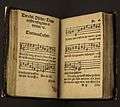Mitten wir im Leben sind
| "Mitten wir im Leben sind" | |
|---|---|
| Hymn by Martin Luther | |
.jpg) Luther's hymn in three stanzas in the Erfurt Enchiridion (1524) | |
| English | In the Midst of Life we are in Death |
| Text | by Martin Luther |
| Language | German |
| Based on | "Media vita in morte sumus" |
| Published | 1524 |
|
| |
"Mitten wir im Leben sind mit dem Tod umfangen" ("In the Midst of Life we are in Death") is a Lutheran hymn, with words written by Martin Luther based on the Latin antiphon "Media vita in morte sumus". The hymn in three stanzas was first published in 1524. The hymn inspired composers from the Renaissance to contemporary to write chorale preludes and vocal compositions. Catherine Winkworth translated Luthers song to English in 1862. It has appeared in hymnals of various denominations.
History
The Latin antiphon "Media vita in morte sumus" dates back to the 11th century. A German version appeared in Salzburg in 1465. Martin Luther added in 1524 two stanzas following the same scheme. The hymn appeared first that year in Eyn geystlich Gesangk Buchleyn, (booklet of spiritual song), collected by Johann Walter with a melody that Walter adapted from the antiphon.[1] The same year it appeared also in Eyn Enchiridion in Erfurt, titled "Der Lobsanck / Mitten wir ym leben synd." (The song of praise /).
Catherine Winkworth translated Luthers hymn to English in 1862, titled "In the Midst of Life".[2] A translation titled "In the Very Midst of Life" appeared in 1941 in The Lutheran Hymnal.[3] It has appeared in hymnals of various denominations. The song is part of the Protestant hymnal Evangelisches Gesangbuch as EG 518.[4] The first stanza is included in the Catholic hymnal Gotteslob as GL 503.
Text
The Latin text has ten lines of different length, with irregular meter.[2] Lines 7 to 9 are reminiscent of the Trisagion, "Sanctus deus, Sanctus fortis, Sanctus immortalis, miserere nobis" (Holy God, Holy Strong One, Holy Immortal One, have mercy on us).[4]
When Luther added two stanzas, he kept the structure, rendering the final request for mercy in each stanza as the Greek "Kyrieleis". From stanza to stanza, a line explains the respective line in the previous stanza, leading from death in the midst of life to hell in the midst of death, in the third stanza to sin as the reason for fear of hell.[2][5] Biblical sources for Luther's stanzas are Romans 14:7–8), 1 Corinthians 1:9–10), 1 Corinthians 15:53–54).[3]
.jpg)
The lyrics are given in todays form, with the Latin original corresponding to the first stanza:
|
(1) Mitten wir im Leben sind
(2) Mitten in dem Tod anficht |
Latin Media vita (3) Mitten in der Hölle Angst |
Melody and setting
The melody printed in the Wittenberg is based on the earlier one, adapted by Johann Walter.[4]
Felix Mendelssohn composed an eight-part motet a cappella as the third part of his Kirchenmusik, Op. 23.[6][7] Enjott Schneider wrote in 2015 a piece for organ and percussion, called Media vita - Mitten wir im Leben sind.[8]
See also
References
| Wikimedia Commons has media related to Mitten wir im Leben sind mit dem Tod umfangen. |
| German Wikisource has original text related to this article: |
| German Wikisource has original text related to this article: |
- ↑ "33. Mitten wir im Leben sind" (PDF). Luther-Gesellschaft. Retrieved 19 November 2014.
- 1 2 3 "Media vita in morte sumus". CPDL. Retrieved 19 November 2014.
- 1 2 "In the Very Midst of Life". hymnary.org. Retrieved 19 November 2014.
- 1 2 3 Schulz, Frieder (2003). 185.4 Agios o Theos. Liederkunde zum Evangelischen Gesangbuch (in German). Vandenhoeck & Ruprecht. pp. 63, 84. ISBN 9783525503300.
- ↑ "Mitten wir im Leben sind". hymnary.org. Retrieved 19 November 2014.
- ↑ "Mitten wir im Leben sind, Op. 23, No. 3 (Felix Mendelssohn)". CPDL. Retrieved 26 November 2014.
- ↑ ""Mitten wir im Leben sind", op. 23,4" (in German). Villa Musica. Retrieved 26 November 2014.
- ↑ Schneider, Enjott. ""Media vita - Mitten wir im Leben sind" für Orgel und Percussion (2015)" (in German). Enjott Schneider. Retrieved 26 November 2016.
